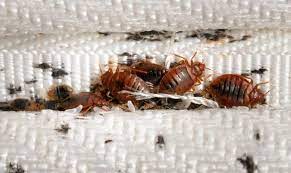Bed bugs, despite their diminutive size, can wreak havoc in our lives.
These tiny, nocturnal pests feed on human blood and are notorious for causing discomfort and distress. Identifying a bed bug infestation early is crucial for effective eradication and preventing further spread. In this guide, we’ll delve into the telltale signs of bed bugs and equip you with the knowledge to check for their presence in your home.
Understanding Bed Bugs
Before we delve into the methods of detection, it’s essential to understand the enemy. Bed bugs, scientifically known as Cimex lectularius, are small, oval-shaped insects that are reddish-brown in colour. They are primarily active at night and are attracted to the warmth and carbon dioxide emitted by humans, which is why they often inhabit bedding, mattresses, and furniture close to sleeping areas.
Signs of Bed Bug Presence
Bite Marks: One of the most common indications of a bed bug infestation is waking up with itchy, red bite marks on your skin. These bites often appear in clusters or a line pattern and are typically found on exposed areas such as the face, neck, arms, and hands.
Blood Stains: Bed bugs are messy feeders and may leave behind small bloodstains on your sheets or pillowcases.
These stains can result from accidentally squashing a bed bug after it has fed or from the bed bug being engorged with blood and leaking some as it moves.
Fecal Stains: Another telltale sign of bed bugs is the presence of dark, rust-colored spots on your bedding, mattress, or nearby furniture. These stains are excrement left behind by bed bugs and are often found in areas where they hide during the day.
Eggshells and Shed Skins: Bed bugs molt as they grow, leaving behind shed skins that are translucent and may appear as empty exoskeletons. Additionally, bed bug eggs are tiny, white, and oval-shaped, resembling grains of rice, and can often be found in clusters near their hiding spots.
Musty Odor: In severe infestations, a musty or sweet odor may be present in the affected area. This odour is produced by the glands of bed bugs and can be particularly noticeable in enclosed spaces like bedrooms.
Methods of Detection
Now that you’re familiar with the signs of bed bug infestation, let’s explore how to conduct a thorough inspection of your home.
Inspect Bedding and Furniture: Start by examining your mattress, box spring, bed frame, and nearby furniture for any signs of bed bugs or their hiding spots. Use a flashlight and magnifying glass to look for live bugs, eggs, shed skins, fecal stains, or blood stains.
Check Cracks and Crevices: Bed bugs are adept at hiding in cracks and crevices, so be sure to inspect baseboards, electrical outlets, picture frames, and any other potential hiding spots near the bed. Pay special attention to seams, folds, and tufts in mattresses and upholstered furniture.
Use Interception Devices: Place interception devices, such as bed bug interceptors or sticky traps, beneath the legs of your bed and furniture. These devices can help capture any bed bugs attempting to climb onto or escape from your bed, providing early detection of an infestation.
Monitor Bed Bug Activity: Keep track of any signs of bed bug activity over time by regularly inspecting your bedding and furniture. You can also lay out bed bug monitors to trap them and have evidence of them. If you suspect an infestation but haven’t found conclusive evidence, consider hiring a professional pest control company to conduct a thorough inspection.
Prevention and Treatment
Preventing bed bug infestations is often more manageable than dealing with an existing one. Here are some preventive measures you can take to reduce the risk of bed bugs in your home.
Encase Mattresses and Box Springs: Invest in bed bug-proof mattress and box spring encasements to prevent bed bugs from entering or escaping these areas.
Reduce Clutter: Minimize clutter in your home to eliminate potential hiding spots for bed bugs. Regularly vacuum and clean your living spaces to remove any potential food sources for bed bugs, such as crumbs or spills.
Inspect Secondhand Items: Before bringing secondhand furniture or clothing into your home, thoroughly inspect them for any signs of bed bugs. Avoid picking up discarded items from the curb, as they may be infested with bed bugs.
Be Vigilant While Traveling: When staying in hotels or other accommodations, inspect the bedding and furniture for signs of bed bugs before unpacking. Keep your luggage elevated and away from the bed, and wash your clothing in hot water immediately upon returning home.
Conclusion
Bed bugs are persistent pests that can quickly turn your sanctuary into a nightmare. By familiarizing yourself with the signs of bed bug infestation and conducting regular inspections of your home, you can catch these elusive insects before they multiply and spread. Remember, early detection is key to effective bed bug control, so don’t hesitate to seek professional help if you suspect an infestation beyond your control. With diligence and proactive measures, you can safeguard your home and family from the discomfort and inconvenience of bed bugs.




